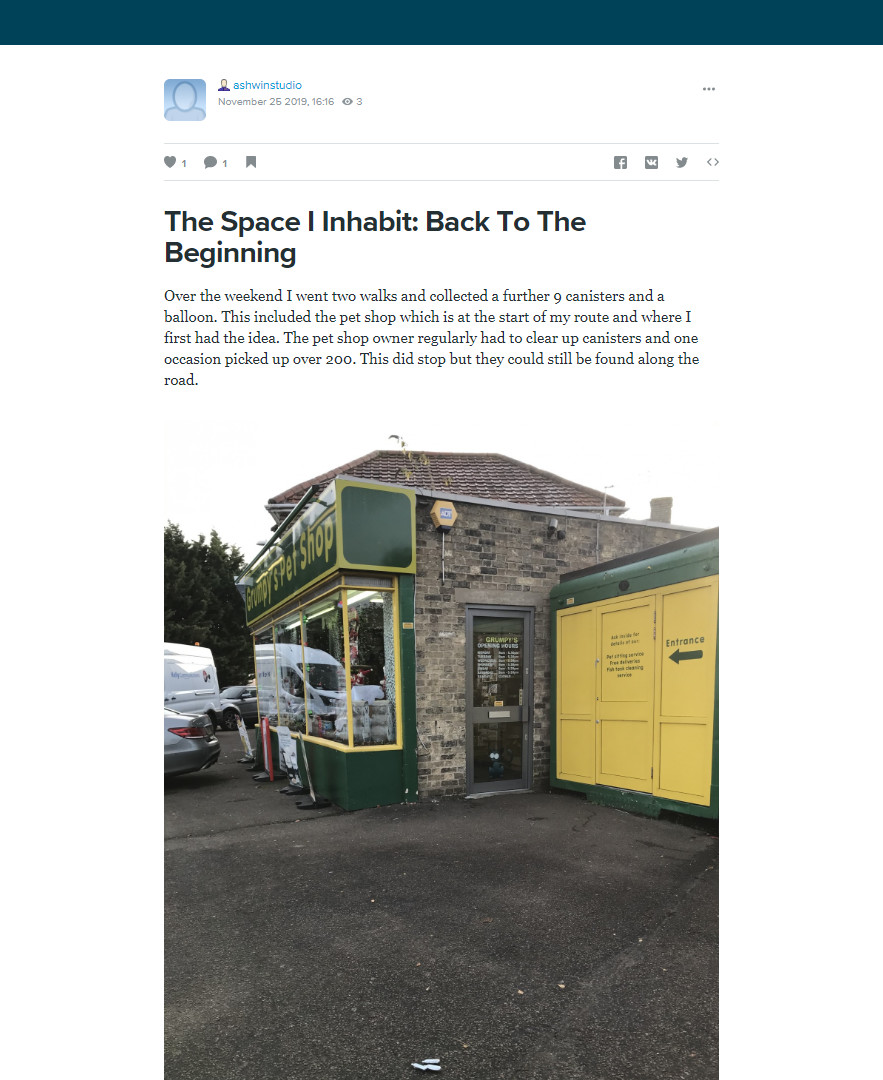The Space I Inhabit
"If you don't stand for something, you will fall for anything"
attributed to Alexander Hamilton, cited by Mika Hunnula
The Space I Inhabit is a multipart artwork documenting a series walks I made along a predefined route over a period of three months. My intention was to record and collect the nitrous oxide canisters found littering local paths and roads. The final artwork is split into three parts; a digital journal where I documented each walk with written observation an photographs, an endless mirrored landscape created using all of the canisters, and a printed journal.
The inspiration came from walking around Cambridge, visiting outdoor events and festivals where I was struck by the amount of rubbish left behind and even when bins were close by. Furthermore, I started to notice a growing number of shiny metal objects appearing on the paths and roads, so I decided to investigate and soon realised they were nitrous oxide canisters. Soon after, I witnessed driver after driver using canisters to fill balloons, inhaling the gas for a short high and then dispose of them out the window. All this, whilst driving at speed in a built-up area.
To me, as I set off on one of my walks, it is like prospecting as I collect the shiny metal objects. Part of me hoped to find a bag full but, for the sake of the environment, I hope to return with an empty bag. Already, I have discovered that early Saturday and Sunday mornings are the most productive times to collect – after the users have had their Friday and Saturday night highs.
The canisters are interesting objects, reflecting the sun, car headlamps and glimmer on the roads. However, their shape is also reminiscent of bombs and they also remind me of bodies – some are spotless, others are crushed by cars. Most of all, they speak to me of our throwaway culture.

The Space I Inhabit - Endless Landscape
The endless landscape represents the future wasteland we risk if we do not do more to save our planet.
The dimensions for the viewing aperture are sized according to the golden ratio - the formula traditionally used in landscape painting. I like to experiment with the interplay between two and three dimension and the mirror pushes this even further. Furthermore, what constitutes a painting or sculpture.
Unsustainable
Nitrous oxide canisters are mostly produced for creating whipped cream. It is also known as laughing gas, hippie crack, whippits, chargers, nangs, NOZ and NOS are now the second most popular drug among 16 - 24 year olds. Potential side effects include, dizziness through lack of oxygen and deficiency in vitamin B12 which can stop white blood cells forming.
We are using up resources and discarding with little thought to the future and or to society as a whole. It costs money to clear litter, money that could be spent elsewhere. Studies have also shown that littering can have an impact on people's mental wellbeing and community spirit.
In a recent report 'Your NOS Habit Is Trashing the Earth' Sam Nichols wrote: 'Green Chief Recycling is a business based in New South Wales. They're contracted to clean up after all the big festivals, and Amie explains that on average she and her team will collect somewhere between 500 kgs to a tonne of empty nangs. And then, because nangs are too dangerous to be recycled, they usually end up in landfill. This in itself isn't an issue. Nangs are made from fairly inert materials so they have little environmental impact. But as Amie explains, "The problem here is the amount of energy raw materials used in creating the canisters, for only one purpose."
It takes a lot to produce a container that can safely hold highly pressurised gas. For this reason, nang bulbs are made from 3mm thick galvanised steel. Notwithstanding the fact that so much steel could go to better use, the smelting process produce heaps of greenhouse gas. According to the Intergovernmental Panel on Climate Change's Fourth Assessment Report, one tonne of steel can produce 1.25 to 3.8 tonnes of carbon dioxide. With nangs being the 7th most popular drug in the world, a lot of CO2 is pretty needlessly going into the atmosphere.'
The Space I Inhabit - Printed Journal
I created a printed limited edition journal to exhibited in a gallery space and for sale.


